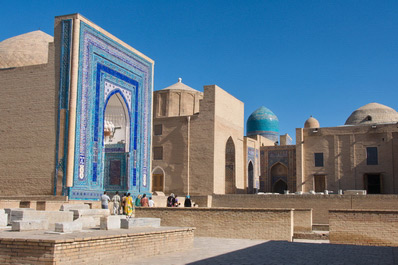Shah-i-Zinda Complex, Samarkand

The Shah-i-Zinda Complex in Samarkand is a Timurid-era necropolis built near the burial site of Kusam ibn Abbas, a cousin of the Prophet Muhammad (7th century). This unique medieval monument showcases the architectural beauty and rich cultural heritage of Uzbekistan and exemplifies Central Asian construction art.
The site contains rare 11th-century graves, though most date back to the 14th and 15th centuries, including tombs of Tamerlane’s family members and high-ranking officials.
Legend
"Shah-i-Zinda" translates to “Living King” and reflects the local reverence for a relative and early follower of the Prophet Muhammad, inspired by an ancient legend. According to the story, Kusam ibn Abbas arrived in Samarkand to spread Islam but was wounded by Zoroastrians who resisted conversion. The sage Hazrat-Khizr is said to have saved him by helping him hide in a well where he drank holy water and gained eternal life, earning the title Shah-i-Zinda - “Living King”, and built a false tomb in Samarkand.
Though Kusam ibn Abbas did pass away in the 7th century, a grand mausoleum was later built over his tomb and rebuilt over time. The tomb, built by order of Amir Timur, has survived to this day. The mausoleum includes a small mosque, a ziarathona (prayer space), and a chillyakhona (a room for 40-day fasting prayers).
Shah-i-Zinda Necropolis, burials in which have not been performed since the XIX century, includes over 20 structures, such as tombs, mosques and other religious buildings. The Shah-i-Zinda Necropolis requires a climb up 40 steps. Many believe that climbing these steps cleanses the soul, with each step accompanied by a prayer. For others, it is a playful challenge to make a wish, count the steps on the way up and down, and hope they match, as this is thought to grant the wish.
Adjacent to the complex is a city cemetery where renowned Muslims of Samarkand rest.
Visitors are reminded to dress modestly, as Shah-i-Zinda is a sacred site.
Architecture
The mausoleums of Shah-i-Zinda line a single narrow street, each displaying unique designs yet forming a unified composition. The hallmark of the complex is the use of glazed tiles in vibrant blue and turquoise, with intricate Arabic inscriptions, beautifully contrasting with the earthy, burnt-brick walls. In recent years, Shah-i-Zinda has become not only a pilgrimage site but also a favorite destination for photography due to its beauty.
Nearby, other notable landmarks include the Bibi-Khanum and Hazrat-Khizr mosques, the ancient Afrasiab settlement, the Samarkand History Museum, the mausoleum of Prophet Daniel (Khoja Daniyar), and the bustling Siab Bazaar.





